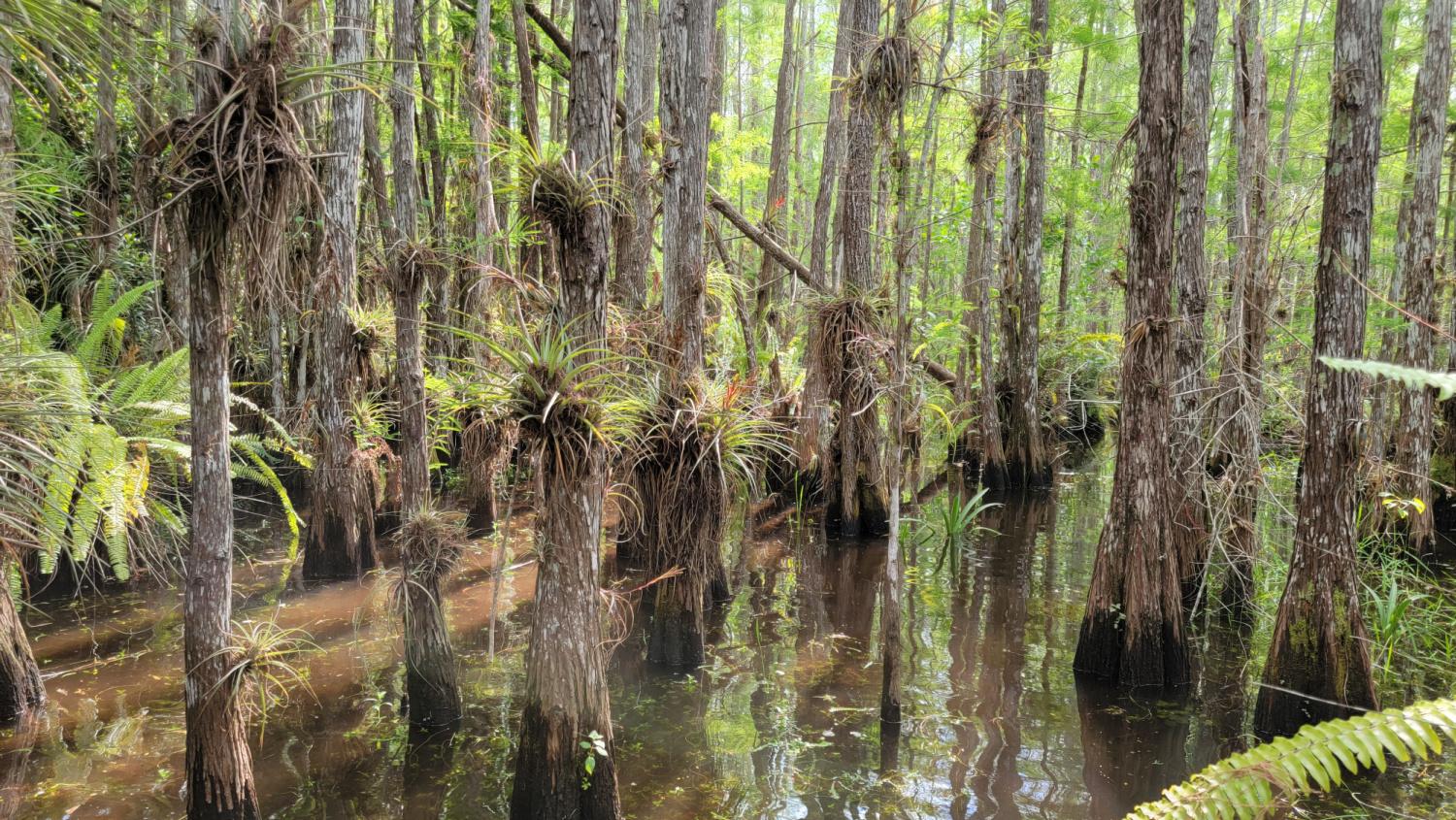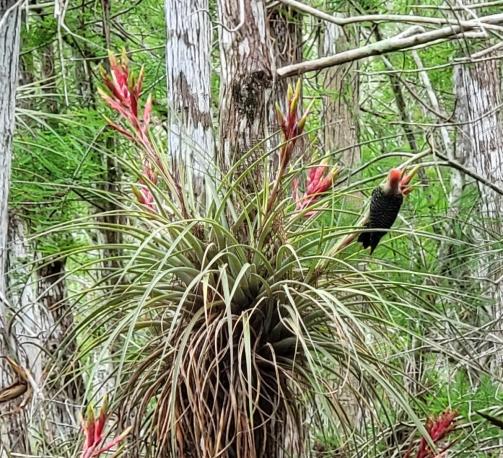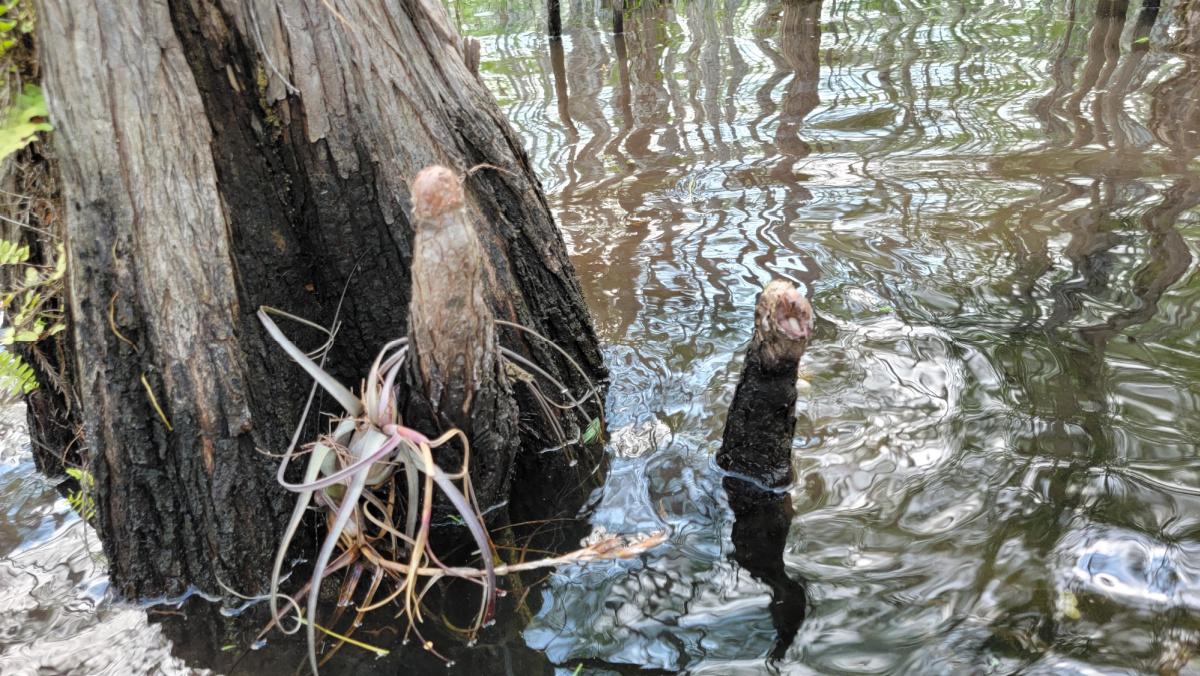
An otherworldly bald cypress forest in the watery wilderness of the Everglades/ Kim O'Connell
Wet Feet And Wild Thoughts
Avoiding alligators—real and imagined—on a slough slog in the Everglades.
By Kim O’Connell
EVERGLADES NATIONAL PARK -- At least the water is clear.
This is my first thought as I take one ginger step into a bald cypress forest in Everglades National Park. Instantly, the water is at my ankle. Through the iced-tea colored water, I can still see my shoe—a good sign. So I take another step—now both feet are wet. I steady myself on the uneven, rocky ground beneath my feet and proceed into a bald cypress dome.
One of the most distinctive landscape types in the Everglades, cypress domes have a somewhat misleading name. A cypress dome is essentially an island of trees in a wetland landscape. From a distance, cypress trees form a rounded shape that seems to imply a small, wide hill. But rather than an elevated rise, a cypress dome is actually a water-filled depression, like a wide, shallow pond with trees growing out of it. The deepest water is at the center of the dome, so there the cypress trees grow taller than the ones growing in shallower water around the edge, giving the formation its arched shape.
So the more I walk, the deeper into the water I go. I’m here with Everglades Ranger Yvette Cano, an education specialist in the park, and the National Parks Traveler Editor Kurt Repanshek. We’re doing what is known as a slough slog, a wet hike through Taylor Slough, one of two such waterways in the Everglades. A slough is a low-lying area that channels freshwater through what are essentially lazy, marshy rivers. These sloughs form the famous “river of grass” that characterizes the Everglades—slow-moving, pond-like, but steady in their progress from Lake Okeechobee south to the Florida Bay. Along with Shark River Slough to the northwest, Taylor Slough helps to fuel the immense diversity of vegetation and wildlife that exists in the Everglades. Compared to other areas of the park, the sloughs can get relatively deep and remain flooded almost year-round, even in the dry season from December through April.

A woodpecker taps away at a bald cypress tree festooned with one of the park's famous bromeliads, a cardinal air plant. / Kim O'Connell
Cano explains how a cypress dome contrasts with a hardwood hammock, large areas of forest in the Everglades that are high and dry—or as high as anything gets in South Florida, where the average elevation rarely reaches above 10 feet above sea level. If the hardwood hammocks are the castles of the Everglades, Cano says, the sloughs and cypress domes and other wetland areas are the moats—havens for reptiles and amphibians, as well as birds, insects, and hundreds of other species.
With every step, the vegetation grows thicker, and the water gets slightly deeper. Now, it’s up to mid-calf, and I can still see my shoes, but it’s getting more difficult. The porous limestone floor is uneven, so that each step can mean an unexpected plunge into hidden depths. I’m well aware that alligators live in the deepest, darkest pockets of these cypress domes, but Ranger Cano assures me that we can avoid them.
Intellectually, I believe her; emotionally, I hear a faint voice telling me to go back to dry ground.
What stops me in my tracks is that we have found ourselves in a landscape of otherworldly beauty, resembling the backdrop of a fantasy film. All around us are bald cypress trees whose broad canopies rise high above us. These resilient native trees grow well in sunlight and shade, and they thrive in wet conditions, their trunks furrowed and lined, broadening at the base where they sit in the deep water. I feel like I’m walking among the giant, heavy legs of dinosaurs.
If the immense cypress trees resemble the legs of large animals, they are surrounded by knobby, stumpy growths known as cypress knees, which punctuate the slough like watery stalagmites or miniature wooden hoodoos. Although one could assume that these short structures are evidence of a tree that fell or failed to thrive, in fact they form essential functions in a cypress forest that are not wholly clear to ecologists. It's probable that they help to aerate root systems and root these tree systems in this shifting, wet landscape.
As we move deeper into the cypress dome, the trees grow more dense, the shadows longer. Hanging from nearly every cypress tree are bromeliads, one of the most vibrant and best-known vegetative families native to Florida and the Everglades. Bromeliads, which count pineapples in their family, include both terrestrial, ground-growing species and epiphytes, which are non-parasitic plants that grow on other plants and literally draw their nourishment from the air, rain, and any debris that might land around it.
The most abundant of these is the cardinal air plant, whose long spidery leaves can exceed three feet in length. Sprouting from nearly every tree visible before me, the air plants stand out because of their bright red bracts, which conceal delicate purple flowers that bloom throughout the spring. To me, they look like fireworks exploding in every direction. This is the Hanging Gardens of Babylon, but in the wild, and in the present, a lush subtropical landcape in which I am literally immersed.
As we continue farther into the cypress dome, it dawns on me that the water has been slowly getting deeper, rising higher and higher on my legs until it reaches mid-thigh. Just as I wonder how much deeper we can possibly go, Cano informs us that we are in the middle of the cypress dome. Here the trees are so tall that we can't see their full crowns. It is in this deepest center section of the dome, Ranger Cano tells us, that we might see gator holes—sections of deep, dark water where gators like to rest and gather.
Soon, we spot one. Not an alligator, but a gator hole, a section of black water near a large, broad cypress tree. We follow Cano in a long, wide circle around the gator hole, and I hold my breath, my mind racing. Is it better to make noise as I walk, like I do when I hike in bear country? Or should I be as silent as possible, keeping my sloshing to a minimum? I opt for silence, moving slowly and carefully, watching for movement. Somewhere nearby, I imagine, an alligator might be doing the same thing.
In our silence the cacophony of the Everglades makes itself known. We hear hooting owls, tapping woodpeckers, buzzing insects. We hear our own breath. The sun slants through the trees of Taylor Slough. Sooner than I want, I notice the water getting shallower again. We are headed out of the cypress dome. Back on dry land, I am surprised to be a little disappointed that we didn't see any alligators after all.

Cypress knees in Taylor Slough in the Everglades. / Kim O'Connell

 Support Essential Coverage of Essential Places
Support Essential Coverage of Essential Places
Add comment